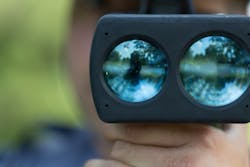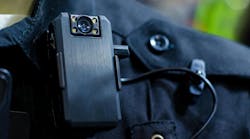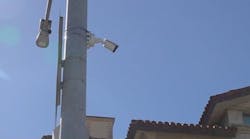You’ve selected a great spot for running LIDAR. There’s good line of sight, no obstructions and you settle in to start hunting speeders. Pull after pull of the trigger and speed readings flash in the display. Suddenly out of nowhere you spot him in the left lane, blowing past slower traffic like a 3,000-pound missile. Your visual estimate puts him at over 100 mph. You aim for a headlight and pull the trigger but the LIDAR gives you no reading. You pull the trigger for longer this time hoping for a reading. The LIDAR beeps rhythmically but still no reading. Suddenly the acquisition tone goes solid and the display shows 55 mph in a posted 55 mph zone.
Was your visual estimate wrong? Is something wrong with the LIDAR? Were you aiming in the wrong place? The other possibility: your LIDAR just got jammed.
RADAR jammers fall under FCC jurisdiction and are illegal in the U.S.; however, LIDAR jammers fall under FDA jurisdiction and they have no prohibitions on the infrared LEDs or LASERs for consumer use. This means speed countermeasure companies are free to produce LASER jammers as they please, and consumers are spending anywhere from $400 to $2,000 to buy these popular items.
Currently 11 states prohibit the use of LASER jammers: California, Colorado, Illinois, Minnesota, Nebraska, Oklahoma, South Carolina, Tennessee, Texas, Utah, Virginia and Washington, D.C. Despite the prohibition in these areas availability of these products is quite easy thanks to online ordering and delivery. Virginia and D.C. remain the last hold out for RADAR detector prohibition; however, approximately 15 percent of RADAR detector owners in portions of Virginia also have a LASER jammer installed as well.
What is a LASER jammer?
LASER jammers are small, electronic devices attached to a vehicle that reduce or eliminate the ability for police speed measurement LIDAR to obtain a reading. Jammers can be found in a few different sizes depending upon where they are meant to be mounted. Since license plates are a primary target for LIDAR operators, one form of jammer is a slim, rectangular shape so that it can be installed using the license plate mounting screws. Other jammers range in size from about three-inches wide to as narrow as one and a half-inches. These smaller, individual-head jammers are usually found in pairs on the front of the vehicle. You will find them within close proximity to the headlights of the vehicle.
LASER jammers use either infrared LEDs or LASERs in the same 900nm spectrum as police LIDAR. Generally, most LED-equipped jammers are not as powerful as jammers with actual LASER diodes and will have more limited effective range. All jammers use a dark red plastic lens that is designed to block visible light and allow infrared light to pass through. These lenses are usually convex in shape over part or all of the jammer head. This shape helps direct incoming LASER energy to the jammer’s IR sensor.
You will find jammers mounted in the grille area of the vehicle either in the center or below the bumper. Also look carefully at the license plate frame itself as some jammers include a license plate frame to help mount and disguise the jammer head itself. For a jammer to work it must have an unobstructed view, therefore they will always be visible. You will find jammers on all kinds of cars, vans, and trucks so do not limit your attention to only high-end sports cars.
Less frequently, jammers can also be found in the rear license plate area. The majority of the rear mounted jammers are the bar-style mounted on the license plate; however, you may find one or more of the individual-head jammers placed on the rear of the car too.
All that glitters
Don’t confuse the license plate mounted automated toll pass devices for LASER jammers. The easiest way to tell is that all LASER jammers will have a cord attached to the jammer head; whereas toll passes are cordless. The other distinguishing feature is that toll passes are missing the dark red translucent lens. When a bright flashlight is activated and placed on the lens you should be able to partially see through it.
At first glance, aftermarket backup cameras may also be confused with jammers. Backup cameras have a cord, are shaped similarly to a bar-style jammer, and are mounted in exactly the same place as a jammer. The distinguishing difference between the two is that jammers are always rectangular and backup cameras have a single round lens not found on jammers.
How they work
Jammers work by detecting the incoming pulses of a LASER light from the LIDAR. Most LASER jammers are extremely sensitive and do not require a direct hit to activate. Instead they are able to detect the incoming LASER light that has been refracted or reflected by moisture, debris in the air, or reflections from the target vehicle’s surfaces. Most all LIDAR speed gun manufacturers utilize a fixed pulse rate between 60 pulses per second and up to 4,000 pulses per second. This makes it very easy for the jammer to detect incoming LASER because pulsed infrared signals are not a natural phenomenon so even the tiniest amount of pulsed energy signals the jammer that the vehicle is being targeted. Within a few milliseconds, the jammer detects the pulse timing and activates the jammers’ own LASERs to fire back at the LIDAR gun with the same frequency of the detected pulses. The jammers slightly mis-time the pulses it fires to prevent the LIDAR from properly measuring the time of flight of its own LASER pulses.
The other reason for jammer effectiveness has to do with the overwhelming return signal-strength coming from the jammer. Like RADAR, the LIDAR speed gun must contend with the “inverse fourth order law,” where the signal strength decreases as target distance increases from the transmitter. The LIDAR’s LASER power decreases on its way to the target vehicle and again after it bounces off the car and heads back to the LIDAR. Because the target vehicle’s LASER jammer only has to go from the jammer to the LIDAR, its energy is significantly stronger than the reflected LASER energy from the target vehicle.
Effects of jamming
Different brands of LIDARs vary in their response to being jammed and some will produce a visible error code when this is happening. Other LIDARs like the Kustom Signals ProLaser III may produce a different acquisition tone; while some other LIDARs may give no indication of the presence of a jamming signal. Regardless of a LIDAR’s ability to detect a jamming signal, it will not display a speed to the LIDAR operator until the jammer is shut off, or when pitted against cheaper jammers, “punch-through” is achieved.
“Punch-through” is the point where the LIDAR is able to overcome the jammer’s countermeasures. This can be caused when the LIDAR is close enough to the target vehicle that its beam is so narrow the jammer’s detector circuits no longer see the incoming LASER pulses. It also can be caused when the energy coming from the LIDAR’s LASER beam overpowers the jammer. Most high-end jammers do not suffer from either of these problems. In cases where the jammer-operator does not shut the system off, the LIDAR may never receive a speed, no matter how close the target vehicle is. Speed and jammer-enthusiasts call this “jam-to-gun.”
If you are unable to receive a speed reading from a vehicle at extremely close distances this is a sign that you may have been jammed.
Some jammers claim to be “parking sensors” and may have documentation to that effect. They may indeed work as a limited range parking sensor; however, their primary function is to jam police LIDAR. Check the Internet for that particular jammer make and model to quickly reveal its true purpose.
Mitigating jammer effectiveness
The single best way to reduce the possibility of getting jammed is to ensure that you operate LIDAR at distances less than 500 feet. Remember that at 1,000 feet most LIDARs produce a 3-foot wide beam pattern. This increases the amount of refracted LASER energy that can get to the jammer sensors. It also increases the amount of surface area on the target that can reflect and refract that LASER energy, thus increasing detectability. Additionally, at distances beyond 500 feet the jammer becomes increasingly effective because its signal is much stronger than the LIDAR’s.
Because most front jammers are mounted on the license plate or near the headlights, aiming for other areas can help reduce the chance of getting jammed. Roofline, mirrors, and engine hoods can be used at close distances when shooting from the front. Since the vast majority of jammer installations are front only, shooting target vehicles from the rear provides a greater chance of obtaining a jam-free reading.
Jammers are designed to be effective as long as the LASER beam from the LIDAR and the jammer are on the same plane. Shooting LIDAR from an elevated position such as a hill, overpass, or exit/on-ramp also makes jamming more difficult.
My testing has found that another limitation of jammers is they are only able to jam one LIDAR at a time. The jammer will alternate back and forth between multiple LIDAR signals allowing them both to get readings at alternating times while the other is jammed. While somewhat impractical, officers who are running LIDAR together may be able to overcome jammers by having each officer shoot the same car.
Jammer-resistant LIDARs
Currently only a few LIDAR manufacturers offer jammer-resistant LIDARs. DragonEye Technologies offers their DragonEye Speed LIDAR and DragonEye Compact and now Stalker RADAR offers their LIDAR RLR. MPH Industries claims their SpeedLaser R, S, T, and SpeedLaser B compact series LIDARs, “Measures speed and beats most jammers while in anti-jammer mode.”
All of these units utilize a variable pulse rate that is fully or partially randomized to prevent jammers from being able to mimic incoming LASER pulse rates. This does not prevent the jammers from detecting the incoming pulses, so the driver will still receive an alert, it just means the jammer will not be able to jam the LIDAR.
Game of cat and mouse
Unfortunately, some models of LASER jammers record their encounters with unknown police LIDAR. The user then sends this data to the jammer manufacturer so that they can better study anti-jamming countermeasures. This means that jammer software updates may be able to overcome existing anti-jamming technology.
On the other hand, LIDAR manufacturers who offer software updates are able to overcome changes in jammer technology too. Thus, it is important to ensure that if you are using a LIDAR with software update capabilities that you keep your equipment current.
With the ever-decreasing cost of electronics it is no wonder that more speed and gadget-enthusiasts are buying and installing LASER jammers. For a few hundred bucks it’s possible to have an effective countermeasure against LASER speed enforcement and LASER-based speed cameras. This assures them freedom from having to endure traffic stops, fines, increased insurance rates, points on their license, court appearances, or jail time.
Even departments in states where jammers are not illegal can benefit from anti-jamming LIDARs and jam-resistant operational strategies.
About the Author
Christopher Ihara is the president and founder of Blacktop Bootcamp, Inc., a company dedicated to teaching drivers advanced, life-saving driving techniques. He can be reached at [email protected].



